The Pittsburgh Protocol: An Alternative Approach to Microbial Remediation
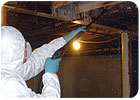
I have never been comfortable with many of the remediation procedures recommended for mold remediation; they just didn’t feel right, either intuitively or instinctively. But these procedures have to be right; after all, they had been developed by people with impressive initials after their names that were much smarter and much more experienced than I.
Unlike asbestos, which is considered a pollutant whether found indoors or outdoors, mold spores and fungal fragments are only considered contaminates when found indoors. As mold spores and fungal fragments are commonly found outdoors, why must we capture them with elaborate and costly equipment? What is the harm in discharging mold spores outdoors? Why the overwhelming fears about cross contamination? Sterility is an absolute condition – something is either sterile or it’s not – while fungal contamination involves degrees of comparative contamination.
The former steel town of Pittsburgh, Penn. is known for its colleges and universities, medical centers and as the home of a successful NFL team. In its history Pittsburgh has on occasion experienced catastrophic flooding. But the city is located hundreds of miles away from the nearest ocean, and is not known to be vulnerable to hurricanes. On Sept. 17, 2004, remnants of Hurricane Ivan dumped 9 inches of water on Pittsburgh. This sudden deluge, combined with a rainy summer, caused severe flooding in towns along the city’s three rivers and the streams that flow into them.
Little did I know this event would have a profound effect on me and change the way I would view, approach and teach microbial remediation. Nor that some of the techniques and procedures developed here would be incorporated in governmental recommendations for microbial remediation.
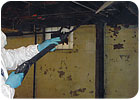
In their time of need, the church relied on a general contractor to provide emergency response, document the damage, prepare an estimate for repairs, negotiate with the insurance company and make the needed repairs. The general contractor relied on a disaster restoration firm to provide emergency services. At the initial inspection, I could see that the emergency responders had flushed most of the mud from the walls and the wooden floor joists and subfloor overhead. They had laid rolled plastic over the exposed soil and installed dehumidifiers, air movers and air scrubbers.
Something had gone horribly wrong. The stone walls and horizontal surfaces were extremely dusty. Severe fungal growth was visible on the wooden floor joists and subfloor. I had never seen so much mold growth in one place before. The demands of the project exceeded the resources of the emergency responders. Their approach was ill-conceived and ineffectual. Rather than mitigating the situation, I suspected they had exacerbated the problem. Their drying equipment dried the mud/soil into dust, then aerosolized and propelled it into the environment, contaminating the entire basement.
There was another complication. The decision maker from the diocese had survived a health crisis, and as such had a heightened awareness to toxic mold. She researched toxic mold on the Internet, and she was convinced that mold is bad, mold is toxic, and mold is a threat to human health. She had purchased and would frequently refer to sections of the IICRC S520 Mold Remediation Standard. She was fixated on toxic mold and seemed unaware and unconcerned about waterborne pathogens. She was seemingly unmindful of a noteworthy incident:
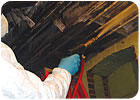
Death of Ross Firefighter Was Caused by Bacteria in Floodwater
Veteran volunteer firefighter died from a blood-borne infection that resulted from his exposure to bacteria in floodwaters. Sometimes called flesh-eating disease, necrotizing fasciitis results when bacteria cause severe breakdown of the skin’s underlying tissues. The coroner’s office said firefighter developed the infection while directing traffic during the recent floods. An ulcer on the firefighter’s leg related to his diabetes was “very fertile ground for bacterial contaminants,” the coroner said.The general contractor requested we provide consulting services, prepare a remediation protocol and perform the needed remediation work. To avoid conflict of interest we agreed to consult and prepare the remedial protocol, while another party would perform the remediation.
Our first challenge was to try and focus everyone’s concern where we felt it needed to be directed. The primary health hazards were posed by pathogens and other contaminates present in the floodwaters. The fungal contamination was secondary. We conducted an Internet search on floodwater contamination and assembled documents from governmental and academic resources supporting our opinion that floodwaters often contain pathogenic microorganisms, agricultural chemicals, industrial chemicals and other hazardous agents.
Through the IICRC S520 Mold Remediation Standard, the client became aware of recommended dry fungal removal methods such as sanding, dry ice and soda blasting. We explained that these methods were appropriate for fungal remediation, and had this project been a fungal remediation project, we may have recommended them. However, as the remedial procedures for mold remediation and sewage intrusion are widely different, either a mold or sewage remediation procedure needed to be employed.
Our second challenge was to gain client trust by proving the validity of our remedial methodology through demonstration.
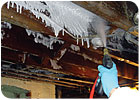
Methods Evaluation
A small-scale remedial methods evaluation was conducted in the convent, where similar levels of contamination existed, to determine the efficacy of the remediation method and ascertain the materials and labor required to complete the project. A test area of 448 square feet (with 1,007 square feet of visibly fungal-contaminated wood above) was randomly selected. Using airtight coverings and an exhaust fan installed in the basement doorway, the basement was placed under negative pressure. HEPA vacuuming was attempted and quickly rejected as a viable single-step remediation option for the fungal contaminated wood, as significant levels of visible contamination remained after vacuuming. A three-step, low-moisture remediation method was also evaluated. The procedure – consisting of HEPA vacuuming, damp wiping by hand, and re-HEPA vacuuming – proved to be ineffectual and time consuming.The Wet Cleaning Process
A plastic 55-gallon drum was utilized as a reservoir for the antimicrobial/cleaning solution. A measured quantity of unheated tap water and 2 ounces per gallon of a concentrated antimicrobial/cleaner were added. The drum was placed on a drum dolly, raising the drum sufficiently to allow the liquid to gravity feed into a small pressure washer. The pressure washer was primed using tap water, and the discharge hose from the pressure washer was attached to the primed intake of the pressure washer.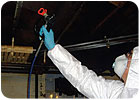
It Must Get Wetter Before It Gets Better
A measured quantity of cleaner/disinfectant solution was placed in a foam generator. An aerated liquid foam of antimicrobial/cleaner was applied to the wood with a foam-generation device. After visible contamination was blanketed with foam, the foam was allowed to dwell for approximately 5 minutes. The wood was then high-pressure/low-volume cleaned (1300 PSI @ 1.5 gallons per minute). After cleaning, an inspection with a high-intensity light, searching for areas inadvertently missed or in which visual fungal-related staining was noticeable, was performed. Areas that had been missed or remained discolored were re-cleaned. The spray pattern of the pressure washer wand was adjusted as needed to enhance stain removal. Following cleaning and quality control inspection, liquid droplets that had accumulated on the floor joists and sub floor were brushed off. Due to time constraints, wooden surfaces were allowed to air dry for one hour and coated with a permeable encapsulant. A video was made to serve as a training tool.The testing showed a significant visible improvement of treated surfaces. There was a high probability that soil, microbial contamination and foreign chemical residues were effectively removed by the remediation process. Following cleaning/remediation, exposed wooden surfaces were encapsulated with a permeable coating, the dried surface film of which is resistant to microbial growth.
- 1 ounce per square foot of pre-cleaning foam solution was expended.
- 4.4 ounces per square foot was expended during cleaning and touchup.
- 0.32 ounces per square foot of encapsulant was expended.
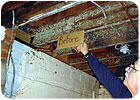
Necessity: The Mother of Invention
For a variety of reasons, including worker safety; time and financial constraints; raw material costs; post-remediation cleaning requirements; and risks of cross contaminating the sanctuary, we decided that the most practical approach was to drastically deviate from recommended industry fungal remediation guidelines and the IICRC S520 Mold Remediation Standard, and recommend that a microbial remedial method based on wet cleaning be utilized to remediate the church basement.As the basement had a dirt floor, to prevent recontamination we specified that a work surface be installed. The dirt floor was neither level nor smooth. We specified that a suitable work surface would be water-resistant, durable, and installed in a watertight manner. A 30-mil PVC geo-membrane material was specified. Spent solution could be vacuumed or absorbed from the floor by the geo-membrane. Post remediation, the geo-membrane would provide additional long-term benefits, serving as a vapor barrier and floor surface so the basement could be used for storage.
The unconventional remedial protocol we developed, using antimicrobial/cleaner and a pressure washer to clean and remediate fungal, bacterial and chemical contamination, proved to be successful. I’m unaware of a more practical, effective, and more cost-efficient method for fungal remediation of wooden materials in crawl spaces and basements.
Following our success on this project, we began sharing our findings with students in our IICRC AMRT and ASCR training courses. Students began providing us with positive feedback. The Pittsburgh Protocol procedure saves money, and we have had indoor environmental professionals conducting post-remediation verification sampling comment on how clean the work sites are and how the sampling results following remediation with this process are superior to results obtained with other processes.
Following Hurricane Katrina, I had the privilege of working alongside with two other ASCR members, Frank Headon of First Restoration Services Charlotte in North Carolina, and Michael Pinto, PhD of Wondermakers Environmental based in Kalamazoo, Mich. on a FEMA Mitigation Assessment Team in New Orleans. The team’s mission was to develop Hurricane Recovery Advisories for damage caused by Hurricanes Katrina and Rita. The interdisciplinary approach teamed remediators with academics, experts on building materials, engineering, wind, flooding and hydraulics. It was gratifying to see recommendations from the Pittsburgh Protocol incorporated into consumer guidance documents prepared by the team.
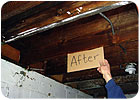
Things to Think About
Rather than naively accepting everything you’re told, ask some questions: Why? Who told you so? What do they know? Does what you’ve been told make sense?People in the cleaning/disaster restoration industry know the efficaciousness and efficiency of cleaning with waterborne cleaning solutions. Why have you been talked out of using wet cleaning for mold remediation? Try it. You’ll see that most of the water used for remediation runs off, and that which remains dries quickly. When you are cleaning with an antimicrobial cleaner, mold spores are rendered nonviable, so there are less mold spores to colonize. If you liked this feature circle 138 on page 51.
Sidebar: Lessons Learned in Pittsburgh
- Remediation should be driven by most prominent and dangerous organisms.
- Deep contamination requires deep cleaning.
- What goes in with water should come out with water. Heavy-duty antimicrobial/cleaners, degreasers and agitation are required.
Sidebar: Recommended Remedial Strategies for Hurricane Work
- Employ aggressive drying strategies.
- Open affected areas. Cut out, pull base moldings, drill holes to facilitate air movement into wall and ceiling cavities.
- Remove contaminates by power washing with cleaner disinfectants.
- Use pressurized drying systems.
- Use antimicrobials to stop growth.
- Treat clothing and textiles, with textile-compatible conservation treatments.
Sidebar: Lessons Learned in New Orleans
- Fungal growth prefers clean water, fungi doesn’t like floodwater.
- OSB holds more water than plywood.
- Don’t use bleach. Bleach is a poor cleaner and is destructive to materials.
- Under the given circumstances heat was the most cost effective drying method.
- Deep contamination requires deep cleaning.
Sidebar: Hurricane Remediation Tactics
- Don’t wait for insurance company.
- Document, use photos, video and moisture mapping.
- Employ aggressive remediation tactics.
Looking for a reprint of this article?
From high-res PDFs to custom plaques, order your copy today!



